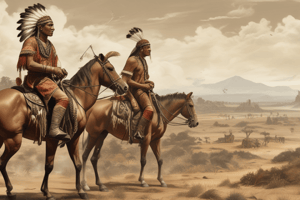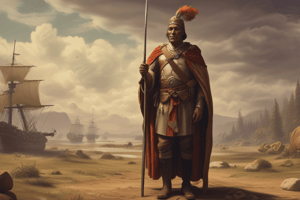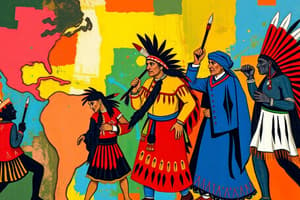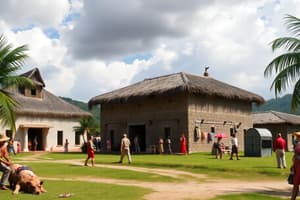Podcast
Questions and Answers
Flashcards
First Peoples
First Peoples
Arrived in Americas around 15,000 BC.
European Colonization
European Colonization
Began in late 15th century in North America.
Thirteen British Colonies
Thirteen British Colonies
Established by the 1760s in North America.
Boston Tea Party
Boston Tea Party
Signup and view all the flashcards
Declaration of Independence
Declaration of Independence
Signup and view all the flashcards
Revolutionary War
Revolutionary War
Signup and view all the flashcards
U.S. Constitution
U.S. Constitution
Signup and view all the flashcards
Bill of Rights
Bill of Rights
Signup and view all the flashcards
Louisiana Purchase
Louisiana Purchase
Signup and view all the flashcards
Manifest Destiny
Manifest Destiny
Signup and view all the flashcards
Civil War
Civil War
Signup and view all the flashcards
Abolition of Slavery
Abolition of Slavery
Signup and view all the flashcards
Reconstruction Era
Reconstruction Era
Signup and view all the flashcards
Jim Crow Laws
Jim Crow Laws
Signup and view all the flashcards
Progressive Movement
Progressive Movement
Signup and view all the flashcards
Great Depression
Great Depression
Signup and view all the flashcards
World War I
World War I
Signup and view all the flashcards
Cold War
Cold War
Signup and view all the flashcards
Civil Rights Movement
Civil Rights Movement
Signup and view all the flashcards
September 11 Attacks
September 11 Attacks
Signup and view all the flashcards
COVID-19 Pandemic
COVID-19 Pandemic
Signup and view all the flashcards
Study Notes
Early Inhabitants and Colonization
- First Peoples arrived in the Americas around 15,000 BCE.
- European colonization began in North America in the late 15th century.
- Thirteen British colonies were established by the 1760s in North America.
- Southern colonies developed an agricultural system reliant on slave labor.
- The Beringia land bridge connected Siberia to Alaska during the Ice Age.
- Paleo-Indians, early inhabitants, diversified culturally.
- Ice Age megafauna (mammoths, etc.) were hunted, later replaced by bison as the primary food source.
- Foraging (gathering wild plants) was a crucial part of their early lives.
- Farming started in central Mexico around 8,000 BCE, and corn cultivation began in the Southwest (Arizona and New Mexico) by 3,000 BCE.
- The Hohokam, a village culture, used advanced irrigation techniques.
- Clovis culture, identified by fluted spear points, existed from 9,100-8,850 BCE.
- Folsom culture, similar to Clovis, used Folsom points.
- Na-Dene-speaking peoples migrated to the Pacific Northwest by 5,000 BCE.
- The Oshara tradition was an archaic Southwest culture from 5,500 BCE to 600 CE.
- The Adena culture was the earliest Mound Builders, starting around 600 BCE.
- Hopewell tradition absorbed Adena, encompassing extensive trade and mound-building.
- The Hopewell Exchange System spanned from the Southeast to Lake Ontario.
- Mississippian culture encompassed multiple groups centered on Cahokia, a major city with a peak population of 20,000.
- Anasazi constructed stone and adobe pueblos around 900 BCE, including Pueblo Bonito.
- The Iroquois Confederacy emerged in the mid-15th century as an alliance of five tribes, and their sachem chiefs were key leaders.
- The Iroquois, a powerful tribe, influenced U.S. politics throughout history and displaced other tribes like the Osage, Kaw, Ponca, and Omaha.
- Hawaiian civilization developed independently until British contact in 1778. Kamehameha I unified the Hawaiian Islands in the late 18th century.
- Puerto Ricans descend from the Taíno.
- The encomienda system harmed the indigenous population.
- Old World diseases decimated Native American populations after contact with Europeans.
- Norse sagas documented Vinland (Norse term for North America) explored in 1075.
- The Mayflower brought early European settlers to America.
- Eurasian diseases like smallpox severely impacted Native Americans.
- Spanish colonization was the first European presence in the U.S.
- Juan Ponce de León landed in Florida in 1513.
- Hernando de Soto extensively explored the Southeast in 1539.
- Francisco Coronado searched for gold, impacting Plains Indians and their adaptation of horsemanship.
- Dutch East India Company sent Henry Hudson to seek a Northwest Passage.
- Henry Hudson explored seeking trade routes for the Dutch.
- Tahitian explorers influenced Hawaiian culture through settlement around 1200 CE.
- New Netherland was established for fur trade in 1621. New Amsterdam was its capital (now New York City).
- Swedish Settlements were established in 19 permanent locations in New Sweden.
- Indigenous treaties existed for land ownership.
- St. Augustine, Florida was the first permanent Spanish settlement (1565).
- Giovanni da Verrazzano was the first European in New York Harbor (1524).
- French Huguenots settled Fort Caroline in Florida in the 1540s.
- Louisiana Plantations were established along the Mississippi River.
- Jamestown, the first successful English colony, was founded by the Virginia Company in 1607.
- The Virginia Company sought profit and gold from Jamestown.
- Colonial conflicts arose due to British expansion.
- Dutch Calvinists showed tolerance of other beliefs.
- Convict transportation brought convicts to colonies (50,000-120,000).
- Native American relations varied from trade to violent conflict.
- Natural inlets facilitated trade along the Atlantic coast.
- Appalachian Mountains hindered westward colonial expansion.
- Second Northern War led to Dutch invasion of New Sweden.
- New Amsterdam experienced rapid growth as a trading center in the mid-1600s.
- Indigenous treaties were made in New Sweeden for land ownership.
- Captain John Smith stabilized Jamestown in its early years.
- Tobacco became Virginia's key revenue source by 1624.
- The Virginia Company chartered Jamestown.
- A royal colony was governed directly by the British crown.
- The Mayflower Compact established self-governance among the Pilgrims.
Colonial Conflicts and Independence
- Puritans settled New England for religious freedom, establishing Plymouth and Massachusetts Bay colonies.
- John Winthrop governed Massachusetts Bay.
- Roger Williams founded Rhode Island for religious freedom.
- Conflicts including the Pequot War and King Philip's War occurred between Puritans and Native Americans.
- The Middle Colonies became a center of ethnic and religious diversity.
- William Penn founded Pennsylvania as a haven for dissenters, with Philadelphia as its commercial center. Southern colonies prioritized agriculture in the Tidewater regions.
- Charleston served as a major port in the Carolinas, with Georgia serving as a buffer against Spanish Florida.
The Revolutionary Period
- The First Great Awakening and the Second Great Awakening were religious revivals influencing American religious identity.
- Evangelicals emphasized personal conversion and piety.
- Revivals were meetings focused on spiritual renewal and conversion.
- Methodists and Baptists gained prominence.
- Indentured servants were a major form of labor in the colonies.
- Slavery was already established as a labor system in the Southern colonies.
- Mercantilism prioritized the colonies' benefits for the mother country.
- Salutary Neglect characterized British policies of minimal enforcement of laws in the colonies.
- The Boston Tea Party and the Stamp Act were examples of colonial resistance.
- The French and Indian War reduced the influence of the French in North America. The Albany Congress sought colonial unity.
- The Royal Proclamation of 1763 restricted colonial expansion, increasing political integration among the colonies.
- Labor shortages and dependence on unfree labor systems shaped the colonial economies. Tobacco plantations in Tidewater drove labor demands.
- Colonial legislatures were responsible for laws and taxes. Governors were appointed colonial officials, responding to increasing immigration toward the Colonies.
- Intolerable Acts led to colonial resistance.
- The First Continental Congress coordinated colonial resistance against Britain, with boycotts of British trade.
- The Declaration of Independence was signed on July 4, 1776, asserting American independence.
- Washington served as commander of the Continental Army, playing a major role in the Revolutionary War and winning through strategies like the Crossing of the Delaware, battles of Lexington and Concord, and the Siege of Yorktown.
- The Treaty of Paris recognized American independence in 1783.
- The Articles of Confederation established the first governing document with limitations on central government power.
- Shays' Rebellion highlighted the weaknesses of the Articles of Confederation, leading to the Northwest Indians War.
Rise of the Nation and Expansion
- The Philadelphia Convention drafted a new Constitution to establish a federal government. The Constitution established the Electoral College and the capital city, Washington, D.C.
- The separation of powers and republican ideals emphasized individual liberties and limited government, gaining traction among nationalists.
- Washington's administrative policies established a strong national government.
- Alexander Hamilton, the Treasury Secretary, implemented financial reforms.
- The Bank of the United States stabilized the economy, creating a Federalist Party.
- Opponents formed the Anti-Federalists, fearing a powerful central government. The Bill of Rights was created to protect individual rights.
- The Democratic-Republican Party emerged as opposition.
- The Jay Treaty restored relations with Britain.
- The First Party System arose from the alignment of Federalists and Republicans.
- The Northwest Indian War challenged the new government.
- The Cherokee-American wars involved conflicts with Native American tribes.
- The Whiskey Rebellion was a protest against federal liquor tax.
- Washington set the precedent of a two-term presidency.
- Alien and Sedition Acts suppressed opposition parties.
- The Quasi-War of 1798 was an undeclared naval conflict with France. Manumission increasingly allowed for slave owners to free slaves and the Atlantic slave trade ban was enacted in 1807.
- The Second Great Awakening fostered growth in Baptist and Methodist congregations.
- The Louisiana Purchase doubled U.S. territory.
- The Lewis and Clark Expedition explored the Louisiana territory. The Jeffersonian republican philosophy favored a government based on independent farmers.
Early 19th and Mid Century
- John Marshall's Supreme Court defined its powers, with Marbury v. Madison (1803) establishing judicial review.
- The War of 1812 involved conflict between the U.S. and Britain over neutral rights.
- The Royal Navy conscripted American sailors.
- Tecumseh led resistance against American expansion in Canada.
- Key battles like Lake Erie and New Orleans led to American victories.
- The Star Spangled Banner arose from the War of 1812.
- The Era of Good Feelings marked national unity post-War of 1812.
- The Federalist party declined. Republican principles were adopted.
- National pride emerged following the War of 1812.
- Second Bank of the United States was established in 1816.
- Tariffs protected American industries. The Monroe Doctrine opposed European colonization.
Expansion and Reform Movements
- Andrew Jackson, the 7th president, opposed central banking.
- The Second Bank of the United States was dissolved by Jackson.
- Pet Banks were state banks used by Jackson, which led to economic instability and the rise of the Democratic party.
- Martin Van Buren played a key role in establishing the Democratic party.
- The Second Party System contrasted Democrats and Whigs.
- The Indian Removal Act facilitated westward Native American relocation, resulting in the Trail of Tears—the forced relocation of the Cherokee Nation.
- The Five Civilized Tribes were significantly affected, with thousands dying during the removals. The California Gold Rush led to rapid migration and population growth in California with San Francisco becoming a major Pacific Coast hub (starting in 1848).
- The Oregon Trail represented another route west.
- Manifest Destiny emphasized belief in U.S. expansion.
- The Seminole Wars involved conflicts against Seminole Indians in Florida. The Treaty of Guadalupe Hidalgo ended the Mexican-American War of 1846-1848.
- The Republic of Texas was annexed by the U.S. in 1845, leading to conflicts over expansion.
Civil War and Reconstruction
- The Civil War (1861-1865) resulted from conflicts over slavery expansion.
- The slave population in 1860 reached four million in the South.
- Abolitionists advocated for the end of slavery.
- Slave rebellions, led by figures like Gabriel Prosser, Denmark Vesey, and Nat Turner, occurred. John Brown's raid further fueled the conflict.
- Important events like the Compromise of 1850, Fugitive Slave Act, Missouri Compromise, and the Kansas-Nebraska Act played key roles in escalating tensions.
- "Bleeding Kansas" exemplified the conflict between pro-slavery and anti-slavery factions.
- The Republican Party gained prominence, dominating Northern states by the late 1850s.
- The Dred Scott v. Sandford case denied citizenship to free Blacks.
- The Confederate States of America was formed.
- The first battle of the Civil War occurred at Fort Sumter. Border states, including Delaware, Maryland, Kentucky, and Missouri, remained in the Union despite having slavery.
- The Union and Confederate armies fought crucial battles like Bull Run, Gettysburg, and Vicksburg. The Emancipation Proclamation freed slaves in Confederate areas.
- Sherman's March to the Sea and the capture of Atlanta were significant campaigns.
- The Civil War ended at Appomattox Court House in 1865 with Grant's victory.
- Reconstruction (1865-1877) followed the Civil War, including the Tenure of Office Act and the impeachment of President Johnson. Key developments included the 13th, 14th, and 15th Amendments, granting citizenship and voting rights to Black people.
- Radical Republicans championed Black civil rights.
- The Ku Klux Klan opposed those rights. The Compromise of 1877 removed federal troops from the South, ending Reconstruction.
Late 19th and Early 20th Century
- The Chinese Exclusion Act limited Chinese immigration. Poll taxes and literacy tests were used to restrict minority voting rights. Andrew Johnson had conflicts with Congress, while Ulysses Grant became president during radical reconstruction.
- Carpetbaggers and scalawags were involved in Reconstruction, with ongoing disenfranchisement. The Transcontinental Railroad connected East and West. Northern European immigration increased in the Prairie States.
- The Jim Crow system enforced racial segregation. The Gilded Age brought wealth and corruption in government. The period’s wealth was largely concentrated in the hands of plutocrats like J.P. Morgan and John D. Rockefeller.
- An immigration wave from 1880 to 1914 brought 22 million immigrants which led to movements to promote labor rights.
- The Progressive movement aimed at addressing corruption and social issues. Muckraking journalism exposed issues.
- The 16th, 17th, 18th, and 19th Amendments were enacted during this time period. This included federal income tax, direct election of Senators, Prohibition, and Women's suffrage, respectively.
- The Pullman Strike and other labor actions occurred.
- The Panic of 1893 caused an economic depression. The Civil service act, interstate commerce act, and the Sherman Antitrust act were enacted.
- The Populist Party supported farmers' interests.
- The gold standard prevailed.
Early 20th Century and World Wars
- The Spanish-American War resulted in U.S. territorial gains, and the Open Door Policy promoted equal trade access in China.
- The Panama Canal was completed, improving trade routes.
- The U.S. became involved in World War I (1917-1918) due to unrestricted submarine warfare and other factors.
- Increased military spending and the creation of the American Expeditionary Forces supported the Allies.
- Sedition and Espionage Acts dealt with dissent during the war.
- The Treaty of Versailles ended WWI, but the U.S. did not join the League of Nations.
- The nation experienced a Red Scare, fear of communist influence leading to deportations.
- The Spanish flu pandemic devastated the populace. The Great Migration involved African American migration to northern cities, with a cultural renaissance occurring.
- The Ku Klux Klan experienced a resurgence in the 1920s.
- The Immigration Act of 1924 limited immigration to the U.S.
- The Great Depression began in 1929.
The Mid-20th and Late 20th Century
- The New Deal programs were formed in response to the Great Depression (1929-1939), including relief, recovery, and reform programs, fostering public works projects and creating jobs. The Wagner and Public works administrations were important parts of this.
- The U.S. was drawn into World War II (1939-1945) with the attack on Pearl Harbor (1941).
- Executive Order 9066 resulted in the internment of Japanese Americans; alliances like the Allied Big Four helped fight.
- War Production Boards prioritized wartime economic mobilization.
- Allied campaigns like D-Day (1944), and the Normandy Campaign in France, Operation Dragoon, Battle of Midway, island hopping strategies, Iwo Jima, and Okinawa resulted in Allied victory over the Axis.
- The Manhattan Project led to the creation of atomic bombs, with bombings in Hiroshima and Nagasaki ending WWII. The U.S occupied Japan post-war.
- The Cold War emerged as a geopolitical tension between the U.S. and the Soviet Union.
- The Korean War and the Vietnam War were prominent global conflicts with U.S. involvement.
- The era saw the emergence of McCarthyism.
- The Civil Rights Movement challenged racial segregation with key figures, like Rosa Parks and Martin Luther King Jr.
- Eisenhower's administration oversaw reduced military spending and social security expansion leading to economic booms and suburban migration.
- The Baby Boom (1945-1964) increased birth rates.
- The Sputnik launch spurred the Space Race and funding for education in science.
- The assassination of Martin Luther King Jr. further impacted the civil rights movement. The rise of the Black Power Movement led to increased activism.
- The Counterculture Revolution emerged in America. Women's rights movements also began in this time, as seen in the Stonewall riots and the publication of "The Feminine Mystique".
Late 20th and Early 21st Century
- Nixon's administration focused on détente.
- The rise of the Environmental Protection Agency aimed to protect the environment.
- The Watergate scandal resulted in Nixon's resignation.
- The Fall of Saigon marked the end of the Vietnam War.
- The OPEC oil embargo in 1973 and increased high energy prices, and the economic downturn in the 1980's, and the emergence of Reaganomics led to the War on Drugs that influenced incarceration rates.
- The AIDS crisis was a major public health concern.
- The Strategic Defense Initiative and the Iran-Contra Affair were controversial aspects of the Reagan administration.
- The Soviet Union collapsed in 1991, ending the Cold War.
- The Gulf War involved the U.S. intervention in the Middle East, focused on military action against Iraq.
- The emergence of technologies like personal computers and increased digitalization changed the economic landscape. This included the Dot-com Bubble and the Great Recession.
- The 2000 Presidential Election had close results. The September 11 attacks led to the War on Terror, which involved invasions of Afghanistan and Iraq.
- Events like the Oklahoma City bombing and the impeachment of President Clinton occurred during this period.
- Post-9/11, the Patriot Act sought to increase government surveillance.
- The Great Recession of 2008 significantly impacted the global economy.
Contemporary Issues and Challenges (Recent History)
- Continued social and political activism pursued movements like the Civil Rights movement, women's rights, and LGBTQ+ rights.
- Modern challenges included the COVID-19 pandemic and other contemporary difficulties. This shaped U.S. foreign policy and domestic actions.
Studying That Suits You
Use AI to generate personalized quizzes and flashcards to suit your learning preferences.




